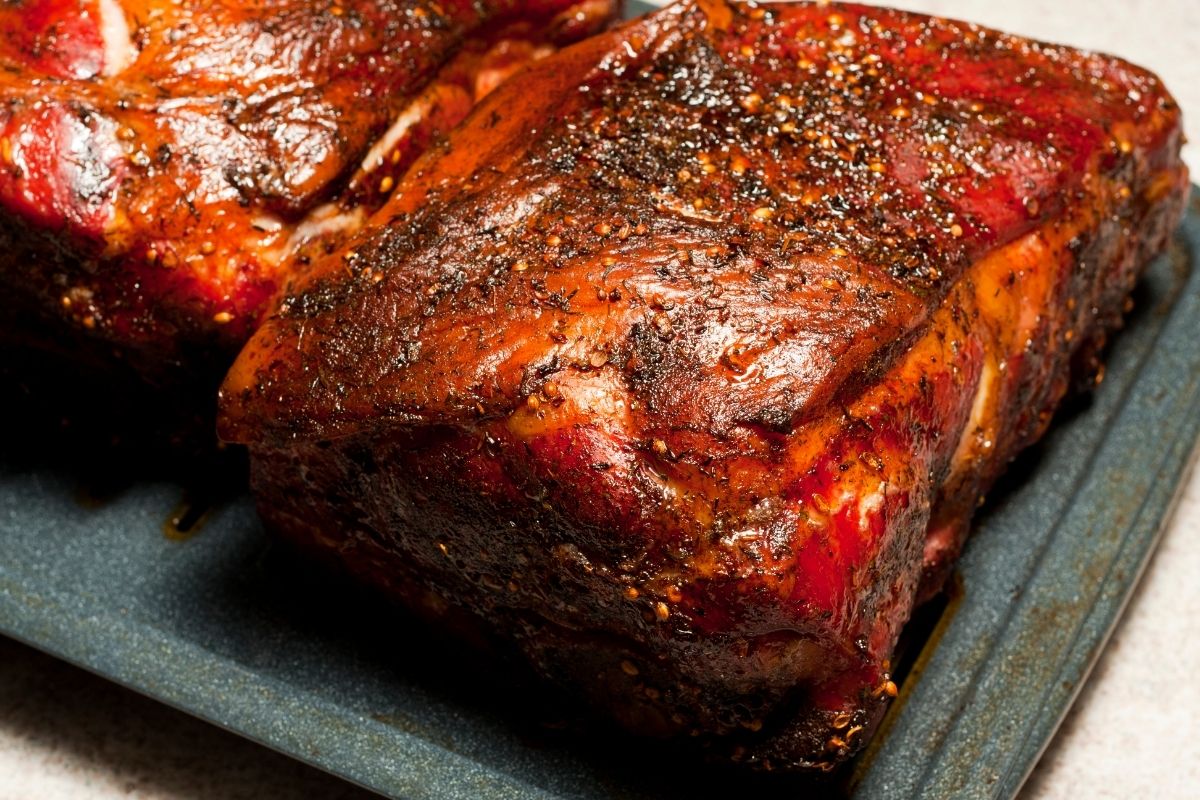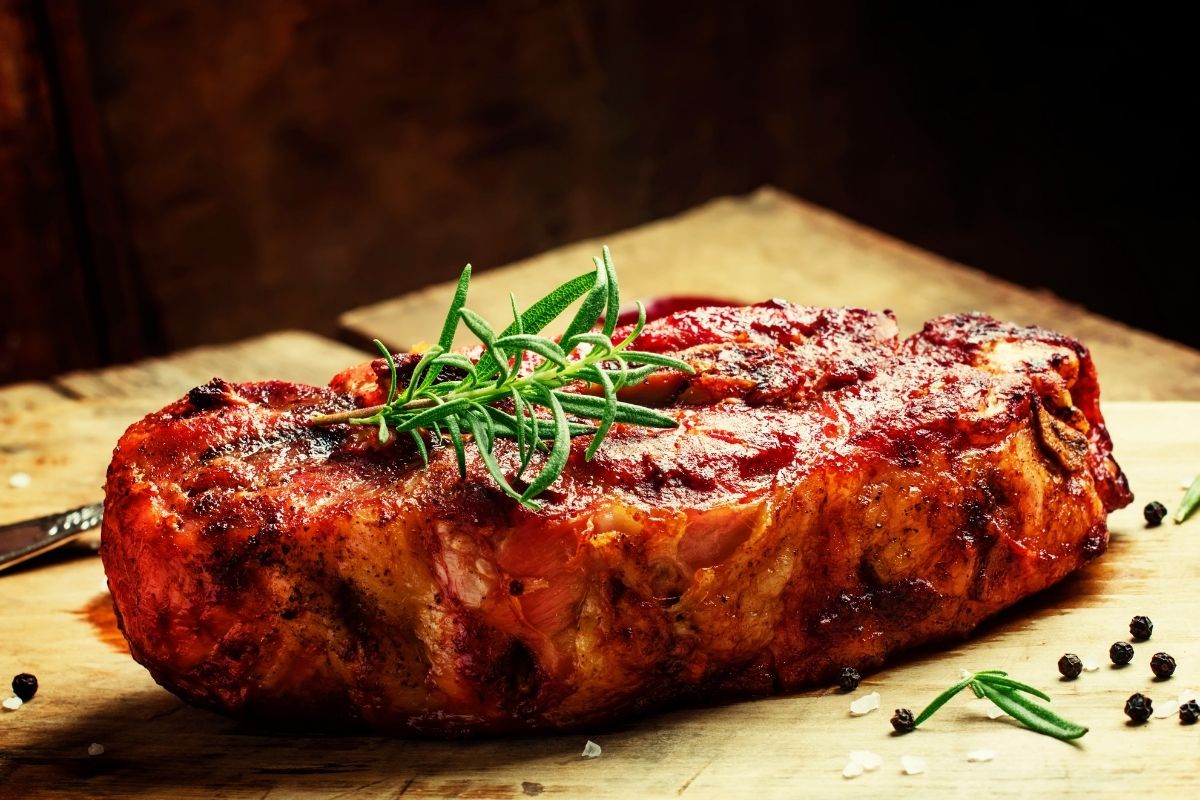When it comes to cooking pig butt (also called Boston butt in some places), this is a very popular choice among people who prefer smoking meat.
Because of the high-fat content of this cut, the meat becomes soft and delectable after being cooked for a long time.

While cooking pork butt is relatively easy, people often forget about one vital step. That is, wrapping the butt.
Wrapping the butt, a process also called “Texas crunch” is a hot topic of debate among pitmasters. People just cannot seem to decide whether wrapping the butt enhances the flavor of the meat enough.
However, if done correctly and at the optimum time and temperature, wrapping the pig butt with aluminum foil makes a considerable difference.
If you want to know more about this method of wrapping, as well as learn some tips and tricks to try out through the cooking process, then read on!
Pork Butt – What You Need To Know
Before we dive into wrapping a Pork butt, let’s look at everything you should know about it first!
Where Is It Cut From?
Despite the name, which may give the idea that this cut comes from the pig’s behind, the pork butt is taken from a location around the pig’s shoulder area.
Another point of confusion is that a cut of butt is taken from a part of the animal that is closer to the shoulder than a cut of pork shoulder is. Pork shoulder is a cut from the pig’s foreleg that is used for roasting.
Why Is It Sometimes Called Boston Butt?
According to some sources, the name “Boston butt” comes from colonial times in New England. Butchers would throw these less attractive pieces of meat inside barrels, which they called “butts,” during this time period.
The meat was transported to other parts of the country, but because it originated in New England, the name Boston Butt stuck.
However, it seems like this story might be made up. Because Southern states controlled the trade of pork throughout the 1800s, the tale doesn’t make sense in the historical context of the time period.
As a final nail in this theory, the term does not appear to have been in print until nearly the end of the 1800s, which means it was probably made up.
What Does It Taste Like?
Whether you call it Boston butt or regular pork butt, there is no denying that this cut is extremely delicious.
Hog butt typically is a flavorful and fatty piece of meat that’s perfect for a hearty barbecue dish like no other.
Slow cooking causes the connective fibers to break down. It also melts the fat, which is absorbed by the meat when it is cooked at moderate temperatures.
If you want to make pulled pork that’s tender and delicious then this is the cut you should make it from.
Wrapping Pork Butt
Now that we have covered what you need to know about Pork butt, let’s move on and look at how we can wrap it!
When Should You Wrap It?
When your butt has achieved an internal temp of 150 – 170 degrees, which is around two-thirds of the way through the cooking period, it’s best to wrap it in aluminum foil to keep it warm.
This will guarantee that it has the best possible combination of flavor and texture.
Why Should You Wrap It?
While pitmasters seem to be divided on if wrapping the butt is necessary, it does provide several advantages.
For a start, covering the Pork will assist in the sealing of the liquids during the last hours of a lengthy cooking period, saving both time and work.
This prevents the melted fat from spreading over the coals as it would if it were not contained by the aluminum foil.
By keeping these juices in, you are also keeping the meat nice and moist. You don’t want to be left with dry and chewy pork after a long day of cooking.
Secondly, wrapping the pork with aluminum foil might assist to bring out the flavor of the meat even further.
Because the meat will have soaked up the smokey flavor for several hours before it is wrapped, the aluminum foil will aid in the preservation of the meat’s flavors.
Finally, because the aluminum foil functions as a mini oven, the wrapping technique can also significantly reduce the amount of time required to cook by several hours if done correctly.
Tips For Cooking The Best Pork Shoulder

Here are some tips, tricks, and guidance for every step of cooking pig butt.
The Rub
For the finest results, marinate the pork for at least 12 hours before cooking. To do this, season it before you go to bed and let it sit in it all night. To bring out the taste, even more, you should leave it in the fridge for 24 hours.
If you don’t have that much time, let the seasoned pork come to room temperature for an hour at the very least before you start cooking. You’ll already be waiting for the grill to heat up, so this process shouldn’t take long.
At a minimum, use 1/2 cup dry rub for an 8-10 pound pork butt. You want a generous coating not some thin layer that is hardly there.
To help keep the rub stuck to your meat, you need to coat the meat with a coating of mustard. Usually, this means using either yellow or Dijon mustard.
Cooking The Butt
Place the pork butt into the smoker and seal the lid after preheating the grill to a temperature of 180-225 degrees.
Cooking time for boneless pig butt at these temperatures is around 90 minutes per pound. If you’ve chosen a bone-in cut, allow approximately two hours per pound of meat to cook.
Even if you want to wrap the meat, it is crucial to do it during the final few hours of cooking. If the pig is wrapped prematurely, it will lose its lovely bark, which barbecue enthusiasts immediately recognize and use to praise a good butt.
After the pork reaches an internal temperature of roughly 150 degrees, the temperature will stop rising for several hours.
This is known as “the stall,” and it is quite normal. So do not be concerned if the meat appears to stall midway through the cooking process.
Wrapping The Butt
Before you even begin to wrap the butt, you need to know exactly at what time in the cooking process you need to do it.
If left unwrapped, it should take around 12 hours to roast a boneless 8-pound pork butt.
Wrapping it approximately two-thirds of the way through the estimated cooking period produces the greatest results, which means taking it from the smoker around the 8-hour mark.
But why should you wait this long to wrap it? Because removing it prematurely prevents the development of the bark.
Additionally, you want to wrap the pork just when it achieves the “stall,” which means that the interior temperature should be at least 150 degrees.
Spread two big sheets of high-quality aluminum foil out on a work area to begin the wrapping process. It is vital to not skimp on quality. If you use cheap foil, it will most likely rip fast, defeating the purpose.
Make sure the foil sheets are at least four times the width of the pork butt’s biggest section.
Arrange the first sheet of foil on a clean countertop or table, shiny side facing you. Arrange the second sheet on top of the first, with approximately half of the width overlapping.
Remove the pig butt off the smoker using tongs and a pair of silicone gloves. Place it in a disposable roasting pan. This is one of those instances when the built-in shelf of your smoker will be useful.
Place the pork butt fat side up on the foil. It should extend approximately eight inches beyond the lowest border of the foil, with the longer side parallel to the bottom.
This is an excellent time to lightly spritz the meat with apple cider vinegar. If you’ve been wiping down the grill with a barbecue mop during the cooking process, feel free to use it in place of the vinegar.
In any case, spray a thin layer across the foil’s surface.
Securely wrap the bottom of the foil around the pork butte. Repeat with the other foil side. Allow enough space while folding the sides to produce a final fold once the meat has been flipped over.
To the opposite side, roll the pig butt. Fold the sides inside one again, making a tight seal. Reverse the wrapped pork and tuck any loose ends inside the wrapper.
Gently squeeze your hands over the wrapper, releasing any trapped air and ensuring that the foil fits snugly around the meat.
Alternatively, the pork butt can be wrapped in butcher paper. While it may take longer to attain the correct temperature, moisture will be allowed to escape, protecting the bark.
When To Take Off The Grill
When the thickest area of the Endgame Pork butt reaches 195 degrees on an instant-read thermometer, remove it off the grill.
Bear in mind that meat continues to cook for a short period of time after it has been withdrawn from the fire. This indicates that the interior temperature should rise another 5 to 10 degrees before serving.
Rest
Before you serve the butt, you must rest the meat. During this period, the natural fluids in the meat will be absorbed into the fibers, resulting in soft, moist pork.
Additionally, the resting period will allow the pork to absorb all of the fluids that have leaked out into the foil.
Rest the foil-wrapped pork for up to two hours before serving. When ready to serve, unwrap the pork carefully and shred the meat with forks or shredding claws.
Summary
Learning how to properly wrap a pork butt is vital to cooking juicy and delicious pork. However, you have to make sure that you wrap it correctly.
Wrapping the pork too quickly results in a lackluster flavor as well as a surface that is too soft to cut through. Waiting too long, on the other hand, raises the possibility of overcooking your pork chops and other meats.
- The 9 Best BBQ Grills for Smoking Brisket - December 29, 2022
- 6 Mouth Watering Grilled Shrimp Recipes - September 16, 2022
- 6 Delicious Grilled Desserts - September 16, 2022
